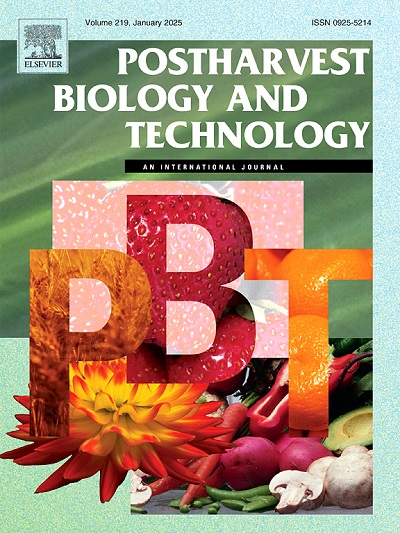酪氨酸- asp处理通过增强氧化还原平衡和维持能量稳态来延缓荔枝果实衰老
IF 6.8
1区 农林科学
Q1 AGRONOMY
引用次数: 0
摘要
荔枝是一种具有重要商业价值的热带和亚热带水果,收获后极易褐变和衰老。二肽是肽的最简单形式,在各种生物过程中起着重要作用。然而,它们对荔枝果实褐变和衰老的具体影响尚不清楚。本研究表明,Tyr-Asp处理能有效延缓荔枝果皮褐变,保持较高的适销比例。Tyr-Asp处理抑制了呼吸速率,导致过氧化氢(H₂O₂)和丙二醛(MDA)水平降低,同时增加谷胱甘肽(GSH)含量。此外,与对照组相比,酪氨酸- asp提高了超氧化物歧化酶(SOD)和过氧化氢酶(CAT)等抗氧化酶的活性,同时抑制了过氧化物酶(POD)的活性。此外,Tyr-Asp处理提高了NADPH/NADP +的比值,但不影响NADH/NAD +的比值。能量状态分析显示,与对照组相比,Tyr-Asp显著增加了能量电荷(EC),表明能量稳态增强。RT-qPCR分析显示,Tyr-Asp降低了能量代谢相关基因(UCP1、GAPDH)和PPO的表达,同时上调了参与抗氧化防御、能量代谢和应激反应的关键基因SOD、CAT、APX1、POD2、DHAR、MDHAR、SnRK2、AtpB和AAC1。这些变化共同导致荔枝果实褐变延迟和衰老。综上所述,Tyr-Asp通过调节荔枝果实关键代谢途径,促进氧化还原平衡,优化能量稳态,从而缓解荔枝褐变,延缓衰老。本文章由计算机程序翻译,如有差异,请以英文原文为准。
Tyr-Asp treatment delays senescence in litchi fruit by enhancing redox balance and maintaining energy homeostasis
Litchi, a tropical and subtropical fruit with significant commercial value, is highly susceptible to browning and senescence after harvest. Dipeptides, the simplest form of peptides, play essential roles in various biological processes. However, their specific effects on litchi fruit browning and senescence remain unclear. This study demonstrated that Tyr-Asp treatment effectively delays browning of the litchi pericarp and maintained a higher proportion of marketable fruit. Tyr-Asp treatment inhibited the respiration rate, leading to reduced levels of hydrogen peroxide (H₂O₂) and malondialdehyde (MDA), while increasing glutathione (GSH) content. Additionally, Tyr-Asp enhanced the activities of antioxidant enzymes, such as superoxide dismutase (SOD) and catalase (CAT), while suppressing the activity of peroxidase (POD) compared to the control group. Moreover, Tyr-Asp treatment improved the NADPH/NADP⁺ ratio without affecting the NADH/NAD⁺ ratio. Energy status analysis revealed that Tyr-Asp notably increases the energy charge (EC) compared to the control group, suggesting enhanced energy homeostasis. RT-qPCR analysis showed that Tyr-Asp reduces the expression of energy metabolism-related genes (UCP1, GAPDH) and PPO, while simultaneously upregulating key genes involved in antioxidant defense, energy metabolism, and stress response, including SOD, CAT, APX1, POD2, DHAR, MDHAR, SnRK2, AtpB, and AAC1. These changes collectively contributed to the delayed browning and senescence of litchi fruit. Overall, these findings indicated that Tyr-Asp alleviates browning and delays senescence in litchi fruit by modulating key metabolic pathways, thereby enhancing redox balance and optimizing energy homeostasis.
求助全文
通过发布文献求助,成功后即可免费获取论文全文。
去求助
来源期刊

Postharvest Biology and Technology
农林科学-农艺学
CiteScore
12.00
自引率
11.40%
发文量
309
审稿时长
38 days
期刊介绍:
The journal is devoted exclusively to the publication of original papers, review articles and frontiers articles on biological and technological postharvest research. This includes the areas of postharvest storage, treatments and underpinning mechanisms, quality evaluation, packaging, handling and distribution of fresh horticultural crops including fruit, vegetables, flowers and nuts, but excluding grains, seeds and forages.
Papers reporting novel insights from fundamental and interdisciplinary research will be particularly encouraged. These disciplines include systems biology, bioinformatics, entomology, plant physiology, plant pathology, (bio)chemistry, engineering, modelling, and technologies for nondestructive testing.
Manuscripts on fresh food crops that will be further processed after postharvest storage, or on food processes beyond refrigeration, packaging and minimal processing will not be considered.
 求助内容:
求助内容: 应助结果提醒方式:
应助结果提醒方式:


